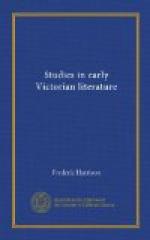Romola, we know, tried its author most cruelly in composition, nor need we wonder at this. “I began it,”, she said, “a young woman—I finished it an old woman.” “It ploughed into her,” said her husband, “more than any of her other books.” And, in my opinion, it marks the decline of her genius. I cannot count any of the later books as equal to her earlier works. Her great period of production reaches at most over the six years 1858-1863 (aetat. 39-45), in which she produced Scenes of Clerical Life (1858), Adam Bede (1859), The Mill on the Floss (1860), Silas Marner (1861), and Romola (1863). If we measure by strict success in the highest art, this period should not be extended beyond the four years which closed with Silas Marner. Romola is an ambitious, beautiful, altogether noble essay to fly skyward like Icarus, whose ingenious mechanism was melted by the sunlight in mid-career. And I cannot count any of the later pieces, prose or verse, as anything but inferior to Romola. They have great beauties, fine passages, subtle characters, and high conceptions—but they are the artificial products of a brain that showed symptoms of exhaustion, of a great writer who was striving after impossible tasks without freedom and without enjoyment.
I cannot at all agree with those admirers of George Eliot’s genius who believe that it grew continuously in power, who even assure us that it reached its zenith in Daniel Deronda. What can they mean? Daniel Deronda, as usual, shows brilliant literary skill in many passages, and its insight into modern Hebraism is a psychological problem. But with all its merits and even beauties, Daniel Deronda has the fatal defect of unpleasant characters who are neither beautiful nor interesting, terrible situations which bore rather than terrify us, a plot which is at once preposterous and wearisome. As to Middlemarch—George Eliot’s longest, most crowded, and ethically most elaborated romance—with all its subtlety, its humour, its variety, and its sardonic insight into provincial Philistinism, it becomes at last tedious and disagreeable by reason of the interminable maunderings of tedious men and women, and the slow and reiterated dissection of disagreeable anatomies. At this moment I cannot, after twenty years, recall the indefinite, lingering plot, or the precise relations to each other of the curiously uninteresting families, who talk scandal and fuss about in Middlemarch town.




